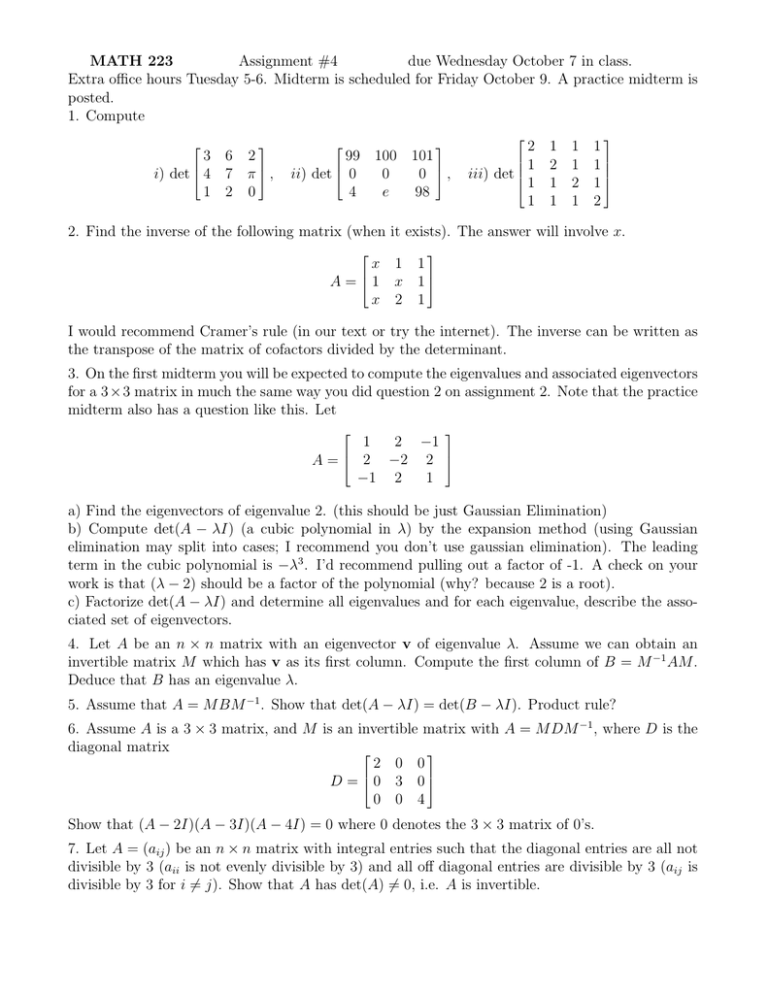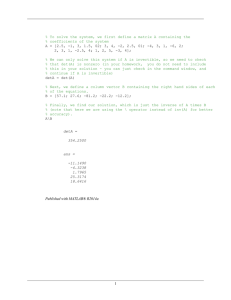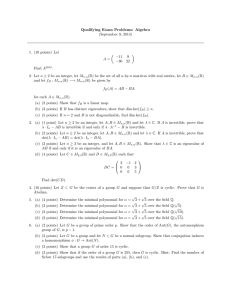MATH 223 Assignment #4 due Wednesday October 7 in class.
advertisement

MATH 223 Assignment #4 due Wednesday October 7 in class. Extra office hours Tuesday 5-6. Midterm is scheduled for Friday October 9. A practice midterm is posted. 1. Compute 3 6 2 i) det 4 7 π , 1 2 0 2 1 iii) det 1 1 99 100 101 ii) det 0 0 0 , 4 e 98 1 2 1 1 1 1 2 1 1 1 1 2 2. Find the inverse of the following matrix (when it exists). The answer will involve x. x 1 1 A = 1 x 1 x 2 1 I would recommend Cramer’s rule (in our text or try the internet). The inverse can be written as the transpose of the matrix of cofactors divided by the determinant. 3. On the first midterm you will be expected to compute the eigenvalues and associated eigenvectors for a 3 × 3 matrix in much the same way you did question 2 on assignment 2. Note that the practice midterm also has a question like this. Let 1 2 −1 A = 2 −2 2 −1 2 1 a) Find the eigenvectors of eigenvalue 2. (this should be just Gaussian Elimination) b) Compute det(A − λI) (a cubic polynomial in λ) by the expansion method (using Gaussian elimination may split into cases; I recommend you don’t use gaussian elimination). The leading term in the cubic polynomial is −λ3 . I’d recommend pulling out a factor of -1. A check on your work is that (λ − 2) should be a factor of the polynomial (why? because 2 is a root). c) Factorize det(A − λI) and determine all eigenvalues and for each eigenvalue, describe the associated set of eigenvectors. 4. Let A be an n × n matrix with an eigenvector v of eigenvalue λ. Assume we can obtain an invertible matrix M which has v as its first column. Compute the first column of B = M −1 AM . Deduce that B has an eigenvalue λ. 5. Assume that A = M BM −1 . Show that det(A − λI) = det(B − λI). Product rule? 6. Assume A is a 3 × 3 matrix, and M is an invertible matrix with A = M DM −1 , where D is the diagonal matrix 2 0 0 D = 0 3 0 0 0 4 Show that (A − 2I)(A − 3I)(A − 4I) = 0 where 0 denotes the 3 × 3 matrix of 0’s. 7. Let A = (aij ) be an n × n matrix with integral entries such that the diagonal entries are all not divisible by 3 (aii is not evenly divisible by 3) and all off diagonal entries are divisible by 3 (aij is divisible by 3 for i 6= j). Show that A has det(A) 6= 0, i.e. A is invertible.







![MA1S12 (Timoney) Tutorial sheet 7b [March 10–14, 2014] Name: Solutions](http://s2.studylib.net/store/data/011008030_1-c04da3e7c2d74dfcf07e513d17d7896f-300x300.png)
